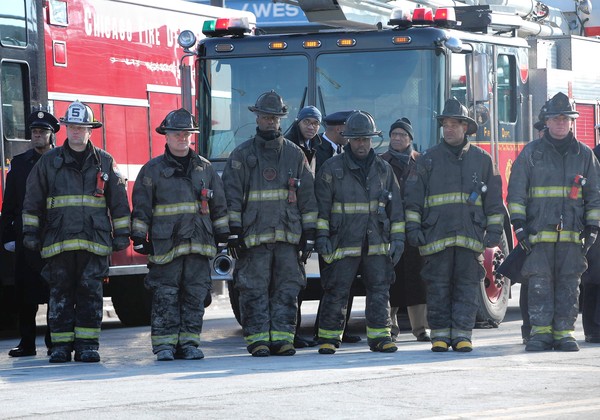A Breed Apart
By Christopher J. Naum, SFPE on Dec 29, 2010 with Comments 0

- Firefighters line Western Avenue on Tuesday after the funeral of Edward Stringer. (E. Jason Wambsgans, Chicago Tribune / December 29, 2010)
Originally Posted by Ron Grossman, Chicago Tribune December 29, 2010
Dennis Smith, a retired member of New York City Fire Department who wrote books about the life, noted how a firefighter differs from you and me: When other people are running out of a burning building, a firefighter races in.
Since childhood, I’ve chased fire engines and ladder trucks. I have a scanner at home to keep up with Chicago Fire Department alarms. I know by heart the equipment deployments for extra-alarm fires — like the 3-11 that took the lives of Stringer and Ankum. Those who share that passion are known as fire buffs, which is misleading. We’re not fans of fire, but of those who fight them.
After a tragedy like the fire last week in an abandoned South Side building, wakes and funerals are big news. But take a look the next time you hear sirens and the thunderous sound of an engine weaving through traffic. Some cars stop or pull over. Others keep right on going. Evidently, those drivers think they are more important than firefighters hurrying to save a person’s life. I’ve seen that through a fire engine’s windshield — autos darting in the pumper’s path as if driven by kamikaze pilots.
“Your job is to hang out the window and curse at them,” the fire engine driver told me.
In high school, I worked in a flower shop where off-duty firefighters served as delivery van drivers. In love with firefighting, they worked on their days off to cobble together an income to comfortably raise a family.
When I was helping make deliveries, they’d sometimes detour to the scene of a recent fire. They could read smoke patterns along broken windows like an FBI agent reading fingerprints. As they saw it, their own prints were on the charred remains, whether or not they’d fought that blaze. Seeing signs of something less than expertise, they’d say: “We blew that one!”
To a firefighter, every firefighter is family. Yet it’s not a closed-door fraternity. Once, I was in an inner-city firehouse encircled by slums and blighted lives. A young boy was seated at a mess-hall table doing his homework. The youngster, who lived nearby, had figured out that if he went to the firehouse he’d be surrounded by adults who cared.
When fire buffs stop by a station, they know they’ll be asked to stay for dinner. It does little good to say you don’t want to impose, as I did at a New York City firehouse. “What’s your hurry?” a firefighter asked. It was three hours to dinner time.
On the job site, it’s a different story. A chief will give a reporter a rundown on a blaze, but an ordinary firefighter is virtually impossible to interview.
He’ll be a great target for a photographer: face covered with soot, wearing a battered helmet and carrying an ax and pike pole that give him the look of a medieval knight. But ask a question and you’ll likely get a laconic answer, as I did while covering a fire in a senior citizens home where firefighters took off their oxygen masks and put them on the old folks they were rescuing.
When I asked a firefighter about it, he said: “Sometimes, you take a bit of a beating.”
En route to becoming a full-fledged firefighter, rookies learn the ways heat can be transmitted, and when a larger hose line should be used. But essentially, the job comes down to a simple formula, explained to me by a firefighter at Engine 22’s quarters on Armitage Avenue.
“You put the wet stuff on the red stuff,” he said.
If a fire is too large to take on directly, chiefs pull firefighters out of the building and order their tower ladders and snorkels to pour streams of water on the blaze. But when firefighters arrived on the site of last week’s tragedy, they worried that homeless people might be inside.
So Stringer, Ankum and the others didn’t fight the blaze from a safe distance.
The next time you’re driving and hear the sirens sound, honor their commitment by pulling over. Or remember them as I will, according to a rare bit of sentimentality that firefighters have allowed themselves. In the old days, the Chicago Fire Department’s annual report included a page dedicated to firefighters who had died.
At the bottom were their names. Above them, a picture of a firefighter with a donut of hose over his arm stepping up a ladder made of clouds. At the top of the page was the radio signal transmitted by companies when their work is done:
“Picked up and returning to quarters.”
rgrossman@tribune.com
Filed Under: In Quarters • Uncategorized























